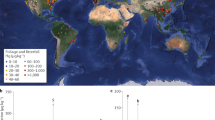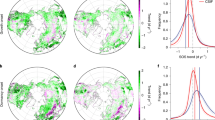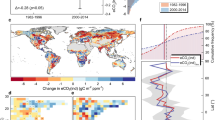Abstract
Anthropogenic mercury emissions are transported through the atmosphere as gaseous elemental mercury (Hg(0)) before they are deposited to Earth’s surface. Strong seasonality in atmospheric Hg(0) concentrations in the Northern Hemisphere has been explained by two factors: anthropogenic Hg(0) emissions are thought to peak in winter due to higher energy consumption, and atmospheric oxidation rates of Hg(0) are faster in summer. Oxidation-driven Hg(0) seasonality should be equally pronounced in the Southern Hemisphere, which is inconsistent with observations of constant year-round Hg(0) levels. Here, we assess the role of Hg(0) uptake by vegetation as an alternative mechanism for driving Hg(0) seasonality. We find that at terrestrial sites in the Northern Hemisphere, Hg(0) co-varies with CO2, which is known to exhibit a minimum in summer when CO2 is assimilated by vegetation. The amplitude of seasonal oscillations in the atmospheric Hg(0) concentration increases with latitude and is larger at inland terrestrial sites than coastal sites. Using satellite data, we find that the photosynthetic activity of vegetation correlates with Hg(0) levels at individual sites and across continents. We suggest that terrestrial vegetation acts as a global Hg(0) pump, which can contribute to seasonal variations of atmospheric Hg(0), and that decreasing Hg(0) levels in the Northern Hemisphere over the past 20 years can be partly attributed to increased terrestrial net primary production.
This is a preview of subscription content, access via your institution
Access options
Access Nature and 54 other Nature Portfolio journals
Get Nature+, our best-value online-access subscription
$29.99 / 30 days
cancel any time
Subscribe to this journal
Receive 12 print issues and online access
$259.00 per year
only $21.58 per issue
Buy this article
- Purchase on Springer Link
- Instant access to full article PDF
Prices may be subject to local taxes which are calculated during checkout




Similar content being viewed by others
References
Krabbenhoft, D. P. & Sunderland, E. M. Global change and mercury. Science 341, 1457–1458 (2013).
Driscoll, C. T., Mason, R. P., Chan, H. M., Jacob, D. J. & Pirrone, N. Mercury as a global pollutant: sources, pathways, and effects. Environ. Sci. Technol. 47, 4967–4983 (2013).
Temme, C. et al. Trend, seasonal and multivariate analysis study of total gaseous mercury data from the Canadian Atmospheric Mercury Measurement Network (CAMNet). Atmos. Environ. 41, 5423–5441 (2007).
Fu, X. W. et al. Observations of atmospheric mercury in China: a critical review. Atmos. Chem. Phys. 15, 9455–9476 (2015).
Weigelt, A. et al. Analysis and interpretation of 18 years of mercury observations since 1996 at Mace Head, Ireland. Atmos. Environ. 100, 85–93 (2015).
Sprovieri, F. et al. Atmospheric mercury concentrations observed at ground-based monitoring sites globally distributed in the framework of the GMOS network. Atmos. Chem. Phys. 16, 11915–11935 (2016).
Holmes, C. D. et al. Global atmospheric model for mercury including oxidation by bromine atoms. Atmos. Chem. Phys. 10, 12037–12057 (2010).
Song, S. et al. Top-down constraints on atmospheric mercury emissions and implications for global biogeochemical cycling. Atmos. Chem. Phys. 15, 7103–7125 (2015).
Horowitz, H. M. et al. A new mechanism for atmospheric mercury redox chemistry: implications for the global mercury budget. Atmos. Chem. Phys. 17, 6353–6371 (2017).
Selin, N. E. et al. Chemical cycling and deposition of atmospheric mercury: global constraints from observations. J. Geophys. Res. 112, D02308 (2007).
Slemr, F. et al. Comparison of mercury concentrations measured at several sites in the Southern Hemisphere. Atmos. Chem. Phys. 15, 3125–3133 (2015).
Khalil, M. A. K. & Rasmussen, R. A. Sources, sinks, and seasonal cycles of atmospheric methane. J. Geophys. Res. Oceans 88, 5131–5144 (1983).
Rea, A. W., Lindberg, S. E., Scherbatskoy, T. & Keeler, G. J. Mercury accumulation in foliage over time in two northern mixed-hardwood forests. Water Air Soil Pollut. 133, 49–67 (2002).
St Louis, V. L. et al. Importance of the forest canopy to fluxes of methyl mercury and total mercury to boreal ecosystems. Environ. Sci. Technol. 35, 3089–3098 (2001).
Lindberg, S. et al. A synthesis of progress and uncertainties in attributing the sources of mercury in deposition. Ambio 36, 19–32 (2007).
Smith-Downey, N. V., Sunderland, E. M. & Jacob, D. J. Anthropogenic impacts on global storage and emissions of mercury from terrestrial soils: insights from a new global model. J. Geophys. Res. Biogeosci. 115, G03008 (2010).
Obrist, D. Atmospheric mercury pollution due to losses of terrestrial carbon pools? Biogeochemistry 85, 119–123 (2007).
Amos, H. M., Jacob, D. J., Streets, D. G. & Sunderland, E. M. Legacy impacts of all-time anthropogenic emissions on the global mercury cycle. Glob. Biogeochem. Cycles 27, 410–421 (2013).
Zhang, L. et al. The estimated six-year mercury dry deposition across North America. Environ. Sci. Technol. 50, 12864–12873 (2016).
Agnan, Y., Le Dantec, T., Moore, C. W., Edwards, G. C. & Obrist, D. New constraints on terrestrial surface-atmosphere fluxes of gaseous elemental mercury using a global database. Environ. Sci. Technol. 50, 507–524 (2016).
Laacouri, A., Nater, E. A. & Kolka, R. K. Distribution and uptake dynamics of mercury in leaves of common deciduous tree species in Minnesota, U.S.A. Environ. Sci. Technol. 47, 10462–10470 (2013).
Obrist, D. et al. Tundra uptake of atmospheric elemental mercury drives Arctic mercury pollution. Nature 547, 201–204 (2017).
Graydon, J. A., St Louis, V. L., Lindberg, S. E., Hintelmann, H. & Krabbenhoft, D. P. Investigation of mercury exchange between forest canopy vegetation and the atmosphere using a new dynamic chamber. Environ. Sci. Technol. 40, 4680–4688 (2006).
Wang, X., Bao, Z., Lin, C. J., Yuan, W. & Feng, X. Assessment of global mercury deposition through litterfall. Environ. Sci. Technol. 50, 8548–8557 (2016).
Zhang, Y. et al. Observed decrease in atmospheric mercury explained by global decline in anthropogenic emissions. Proc. Natl Acad. Sci. USA 113, 526–531 (2016).
Demers, J. D., Blum, J. D. & Zak, D. R. Mercury isotopes in a forested ecosystem: implications for air-surface exchange dynamics and the global mercury cycle. Glob. Biogeochem. Cycles 27, 222–238 (2013).
Enrico, M. et al. Atmospheric mercury transfer to peat bogs dominated by gaseous elemental mercury dry deposition. Environ. Sci. Technol. 50, 2405–2412 (2016).
Jiskra, M. et al. Mercury deposition and re-emission pathways in boreal forest soils investigated with Hg isotope signatures. Environ. Sci. Technol. 49, 7188–7196 (2015).
Keeling, C. D. et al. Atmospheric carbon dioxide variations at Manua Lao observatory, Hawaii. Tellus 28, 538–551 (1976).
Keeling, C. D., Chin, J. F. S. & Whorf, T. P. Increased activity of northern vegetation inferred from atmospheric CO2 measurements. Nature 382, 146–149 (1996).
Denning, A. S., Fung, I. Y. & Randall, D. Latitudinal gradient of atmospheric CO2 due to seasonal exchange with land biota. Nature 376, 240–243 (1995).
Global Mercury Assessment 2013: Sources, Emissions, Releases and Environmental Transport (UNEP Chemicals Branch, Geneva, 2013).
Steffen, A. et al. A synthesis of atmospheric mercury depletion event chemistry in the atmosphere and snow. Atmos. Chem. Phys. 8, 1445–1482 (2008).
Diéguez, M. C. et al. Four years of atmospheric mercury records in Northwestern Patagonia (Argentina): potential sources, concentration patterns and influence of environmental variables observed at the GMOS EMMA station. Atmos. Chem. Phys. Discuss. https://doi.org/10.5194/acp-2016-1076 (2017).
Fritsche, J. et al. Elemental mercury fluxes over a sub-alpine grassland determined with two micrometeorological methods. Atmos. Environ. 42, 2922–2933 (2008).
Poissant, L., Pilote, M., Yumvihoze, E. & Lean, D. Mercury concentrations and foliage/atmosphere fluxes in a maple forest ecosystem in Québec, Canada. J. Geophys. Res. 113, D10307 (2008).
Fu, X. et al. Depletion of atmospheric gaseous elemental mercury by plant uptake at Mt. Changbai, Northeast China. Atmos. Chem. Phys. 16, 12861–12873 (2016).
Wofsy, S. C. et al. Net exchange of CO2 in a midlatitude forest. Science 260, 1314–1317 (1993).
Commane, R. et al. Seasonal fluxes of carbonyl sulfide in a midlatitude forest. Proc. Natl Acad. Sci. USA 112, 14162–14167 (2015).
Wehr, R. et al. Dynamics of canopy stomatal conductance, transpiration, and evaporation in a temperate deciduous forest, validated by carbonyl sulfide uptake. Biogeosciences 14, 389–401 (2017).
Obrist, D. et al. A synthesis of terrestrial mercury in the western United States: spatial distribution defined by land cover and plant productivity. Sci. Total Environ. 568, 522–535 (2016).
Blasing, T. J., Broniak, C. T. & Marland, G. The annual cycle of fossil-fuel carbon dioxide emissions in the United States. Tellus B 57, 107–115 (2011).
Lan, X., Talbot, R., Castro, M., Perry, K. & Luke, W. Seasonal and diurnal variations of atmospheric mercury across the US determined from AMNet monitoring data. Atmos. Chem. Phys. 12, 10569–10582 (2012).
Xu, X. H., Akhtar, U., Clark, K. & Wang, X. B. Temporal variability of atmospheric total gaseous mercury in Windsor, ON, Canada. Atmosphere 5, 536–556 (2014).
Song, S. et al. Constraints from observations and modeling on atmosphere–surface exchange of mercury in eastern North America. Elem. Sci. Anth. 4, 100 (2016).
Bieser, J. et al. in Air Pollution Modeling and its Application XXIII (eds Steyn, D. & Mathur, R.) 189–195 (Springer, Cham, 2014).
Bieser, J. et al. Multi-model study of mercury dispersion in the atmosphere: vertical and interhemispheric distribution of mercury species. Atmos. Chem. Phys. 17, 6925–6955 (2017).
Nemani, R. R. et al. Climate-driven increases in global terrestrial net primary production from 1982 to 1999. Science 300, 1560–1563 (2003).
Zhao, M. & Running, S. W. Drought-induced reduction in global terrestrial net primary production from 2000 through 2009. Science 329, 940–943 (2010).
Campbell, J. E. et al. Large historical growth in global terrestrial gross primary production. Nature 544, 84–87 (2017).
Baccini, A. et al. Estimated carbon dioxide emissions from tropical deforestation improved by carbon-density maps. Nat. Clim. Change 2, 182–185 (2012).
Tørseth, K. et al. Introduction to the European Monitoring and Evaluation Programme (EMEP) and observed atmospheric composition change during 1972–2009. Atmos. Chem. Phys. 12, 5447–5481 (2012).
Dlugokencky, E. J., Lang, P. M., Mund, J. W., Crotwell, A. M., Crotwell, M. J. & Thoning, K. W. Atmospheric Carbon Dioxide Dry Air Mole Fractions from the NOAA ESRL Carbon Cycle Cooperative Global Air Sampling Network, 1968–2015 (NOAA, 2016); ftp://aftp.cmdl.noaa.gov/data/trace_gases/co2/flask/surface/
Jiang, Y., Cizdziel, J. V. & Lu, D. Temporal patterns of atmospheric mercury species in northern Mississippi during 2011–2012: influence of sudden population swings. Chemosphere 93, 1694–1700 (2013).
Lan, X. et al. Seasonal and diurnal variations of total gaseous mercury in urban Houston, TX, USA. Atmosphere 5, 399–419 (2014).
Cole, A. et al. A survey of mercury in air and precipitation across Canada: patterns and trends. Atmosphere 5, 635–668 (2014).
Sheu, G. R. et al. Temporal distribution and potential sources of atmospheric mercury measured at a high-elevation background station in Taiwan. Atmos. Environ. 44, 2393–2400 (2010).
Zhang, L., Wang, S. X., Wang, L. & Hao, J. M. Atmospheric mercury concentration and chemical speciation at a rural site in Beijing, China: implications of mercury emission sources. Atmos. Chem. Phys. 13, 10505–10516 (2013).
Read, K. A. et al. Four years (2011–2015) of total gaseous mercury measurements from the Cape Verde Atmospheric Observatory. Atmos. Chem. Phys. 17, 5393–5406 (2017).
Denzler, B. et al. Inversion approach to validate mercury emissions based on background air monitoring at the High Altitude Research Station Jungfraujoch (3580 m). Environ. Sci. Technol. 51, 2846–2853 (2017).
Howard, D. et al. Atmospheric mercury in the Southern Hemisphere tropics: seasonal and diurnal variations and influence of inter-hemispheric transport. Atmos. Chem. Phys. 17, 11623–11636 (2017).
R Development Core Team R: A Language and Environment for Statistical Computing (R Foundation for Statistical Computing, Vienna, 2015).
Liu, F. et al. High-resolution inventory of technologies, activities, and emissions of coal-fired power plants in China from 1990 to 2010. Atmos. Chem. Phys. 15, 13299–13317 (2015).
Zhu, J., Wang, T., Bieser, J. & Matthias, V. Source attribution and process analysis for atmospheric mercury in eastern China simulated by CMAQ-Hg. Atmos. Chem. Phys. 15, 8767–8779 (2015).
Acknowledgements
We thank those involved in the EMEP efforts and those who have contributed by operating sites, performing chemical analysis and submitting data to the EBAS database. EMEP is funded through national contributions. We gratefully acknowledge the Air Quality Research Division of Environment Canada for the total gaseous mercury data, and the Earth System Research Laboratory at the National Oceanic and Atmospheric Administration and World Data Center for Greenhouse Gases for the CO2 data. This work contributed to the European Union 7th Framework Programme project Global Mercury Observation System. Logistical and financial support was provided by the French Polar Institute Paul-Emile Victor (Program 1028, GMOstral). This work was also funded by H2020 Marie Sklodowska-Curie grant agreement 657195 and Swiss National Science Foundation grant PZ00P2_174101 to M.J., and European Research Council grant ERC-2010-StG_20091028 to J.E.S.
Author information
Authors and Affiliations
Contributions
M.J. initiated the project, performed the data analysis and wrote the manuscript together with J.E.S. and contributions from D.O., J.B. and A.D. J.B., R.E., C.L.M., K.A.P., I.W., K.K., D.W., L.G.M., C.L., T.M., M.R., O.M. and A.D. provided data. All authors read and commented on the manuscript.
Corresponding author
Ethics declarations
Competing interests
The authors declare no competing interests.
Additional information
Publisher’s note: Springer Nature remains neutral with regard to jurisdictional claims in published maps and institutional affiliations.
Supplementary information
Supplementary Information
Supplementary Data Tables, Figures and Discussion
Rights and permissions
About this article
Cite this article
Jiskra, M., Sonke, J.E., Obrist, D. et al. A vegetation control on seasonal variations in global atmospheric mercury concentrations. Nature Geosci 11, 244–250 (2018). https://doi.org/10.1038/s41561-018-0078-8
Received:
Accepted:
Published:
Issue Date:
DOI: https://doi.org/10.1038/s41561-018-0078-8
This article is cited by
-
Comparing ecosystem gaseous elemental mercury fluxes over a deciduous and coniferous forest
Nature Communications (2023)
-
The Roles of the Moss Layer in Mediating Tree Seedling Environmental Stress, Mercury Exposure, and Regeneration in High-Elevation Conifer Forests
Ecosystems (2023)
-
Global change effects on biogeochemical mercury cycling
Ambio (2023)
-
A synthesis of mercury research in the Southern Hemisphere, part 2: Anthropogenic perturbations
Ambio (2023)
-
Mercury distribution in plants and soils from the former mining area of Abbadia San Salvatore (Tuscany, Central Italy)
Environmental Geochemistry and Health (2023)



